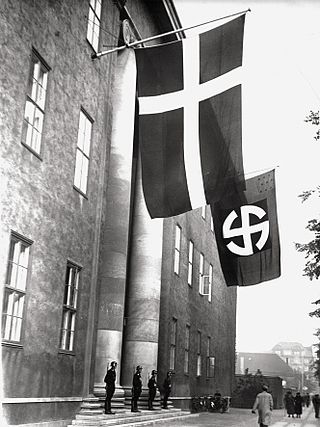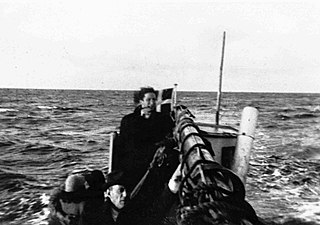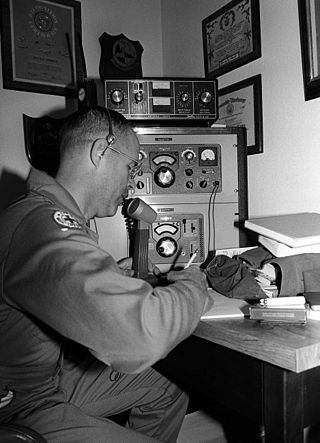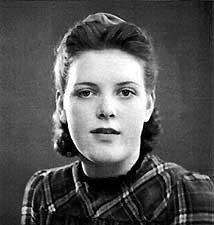
The Geheime Staatspolizei, abbreviated Gestapo, was the official secret police of Nazi Germany and in German-occupied Europe.
Sven Hassel was the pen name of the Danish-born Børge Willy Redsted Pedersen known for his novels about German soldiers fighting in World War II. In Denmark he used the pen name Sven Hazel. He is one of the bestselling Danish authors, possibly second only to Hans Christian Andersen.

At the outset of World War II in September 1939, Denmark declared itself neutral. For most of the war, the country was a protectorate and then an occupied territory of Germany. The decision to occupy Denmark was taken in Berlin on 17 December 1939. On 9 April 1940, Germany occupied Denmark in Operation Weserübung. The Danish government and king functioned in a relatively normal manner in a de facto protectorate over the country until 29 August 1943, when Germany placed Denmark under direct military occupation, which lasted until the Allied victory on 5 May 1945. Contrary to the situation in other countries under German occupation, most Danish institutions continued to function relatively normally until 1945. Both the Danish government and king remained in the country in an uneasy relationship between a democratic and a totalitarian system until 1943 when the Danish government stepped down in protest against German demands that included instituting the death penalty for sabotage.

The Danish resistance movements were an underground insurgency to resist the German occupation of Denmark during World War II. Due to the initially lenient arrangements, in which the Nazi occupation authority allowed the democratic government to stay in power, the resistance movement was slower to develop effective tactics on a wide scale than in some other countries.

The Danish resistance movement, with the assistance of many Danish citizens, managed to evacuate 7,220 of Denmark's 7,800 Jews, plus 686 non-Jewish spouses, by sea to nearby neutral Sweden during the Second World War. The arrest and deportation of Danish Jews was ordered by the German leader Adolf Hitler, but the efforts to save them started earlier due to the plans being leaked on September 28, 1943 by German diplomat Georg Ferdinand Duckwitz.

The Ordnungspolizei, abbreviated Orpo, meaning "Order Police", were the uniformed police force in Nazi Germany from 1936 to 1945. The Orpo organisation was absorbed into the Nazi monopoly on power after regional police jurisdiction was removed in favour of the central Nazi government. The Orpo was controlled nominally by the Interior Ministry, but its executive functions rested with the leadership of the SS until the end of World War II. Owing to their green uniforms, Orpo were also referred to as Grüne Polizei. The force was first established as a centralised organisation uniting the municipal, city, and rural uniformed police that had been organised on a state-by-state basis.

Auxiliaries are support personnel that assist the military or police but are organised differently from regular forces. Auxiliary may be military volunteers undertaking support functions or performing certain duties such as garrison troops, usually on a part-time basis. Unlike a military reserve force, an auxiliary force does not necessarily have the same degree of training or ranking structure as regular soldiers, and it may or may not be integrated into a fighting force. Some auxiliaries, however, are militias composed of former active duty military personnel and actually have better training and combat experience than their regular counterparts.

The peaked cap, peaked hat, service cap, barracks cover or combination cap is a form of headgear worn by the armed forces of many nations, as well as many uniformed civilian organisations such as law enforcement agencies and fire departments. It derives its name from its short visor, or peak, which was historically made of polished leather but increasingly is made of a cheaper synthetic substitute.

The Germanic SS was the collective name given to paramilitary and political organisations established in parts of German-occupied Europe between 1939 and 1945 under the auspices of the Schutzstaffel (SS). The units were modeled on the Allgemeine SS in Nazi Germany and established in Belgium, Denmark, the Netherlands, and Norway—population groups who were considered to be especially "racially suitable" by the Nazis. They typically served as local security police augmenting German units of the Gestapo, Sicherheitsdienst (SD), and other departments of the German Reich Security Main Office (RSHA), rendering them culpable for their participation in Nazi atrocities.

Karl Rudolf Werner Best was a German jurist, police chief, SS-Obergruppenführer, Nazi Party leader, and theoretician from Darmstadt. He was the first chief of Department 1 of the Gestapo, Nazi Germany's secret police, and initiated a registry of all Jews in Germany. As a deputy of SS-Obergruppenführer Reinhard Heydrich, he organized the World War II SS-Einsatzgruppen, paramilitary death squads that carried out mass-murder in Nazi-occupied territories.

During World War II, the Danish government chose to cooperate with the Nazi occupation force. Even though this applied to the Danish police as well, many were reluctant to cooperate. As a result, a large number of members of the Danish police force were deported to Nazi concentration camps in Germany. The Gestapo established the collaborationist HIPO Corps to replace them.
Holger Danske was a Danish resistance group during World War II. It was among the largest Danish resistance groups and consisted of around 350 volunteers towards the end of the war. The group carried out sabotage operations, including blowing up railway lines strategically important to the Germans. Among their largest sabotage actions was the blowing up of the Forum Copenhagen in 1943. Holger Danske was responsible for around 200 killings of informers who had revealed the identity and/or the whereabouts of members of the resistance. The group was named after the legendary Danish hero Holger Danske.

The Hilfspolizei was a short-lived auxiliary police force in Nazi Germany in 1933. The term was later semi-officially used for various auxiliary organizations subordinated to the Ordnungspolizei as well as various military and paramilitary units set up during World War II in German-occupied Europe.
The term Hipo may refer to:
A field force in British and Indian Army military parlance is a combined arms land force operating under actual or assumed combat circumstances, usually for the length of a specific military campaign. It is used by other nations, but can have a different meaning.

The Lorenzen group was an armed paramilitary group of Danish collaborators, subordinate to the HIPO Corps, which was active during the period December 1944 - May 1945.

Stanisławów Ghetto was a ghetto established in 1941 by Nazi Germany in Stanisławów in German occupied Poland. After the German invasion of the Soviet Union, the town was incorporated into District of Galicia, as the fifth district of the General Government.

Erik Crone was a member of the Danish resistance executed by the German occupying power.
Svend Glendau was a member of the Danish resistance executed by the German occupying power.

Maren Margrethe Thomsen, known as Maren Margrethe "Grethe" Bartram and "Thora", was a Danish woman who informed on at least 53 people from the Danish resistance movement during the Second World War, resulting in the early communist resistance groups being dismantled and many of their members being sent to Nazi concentration camps. Bartram informed on her brother, husband and close acquaintances.














